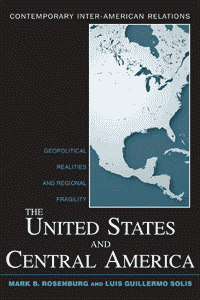
Mark Rosenberg has been studying Central America for more than 30 years. He has seen the region struggle through the 1970s, bleed during the ’80s, regain autonomy and hope in the ’90s, and fall back under the United States security umbrella during the past decade.
And still, “it hasn’t changed much,” he says.
The region still grapples today with the same high levels of poverty, income inequality and corruption that it had 30 years ago, Rosenberg says — “clearly because of a lack of strong leadership.”
Rosenberg, chancellor of the State University System of Florida and a scholar in Latin American affairs (he was the founding director of the Latin American and Caribbean Center at Florida International University), has recently co-authored a book about U.S.-Central American relations with Luis Guillermo Solis, an academic and legislator from Costa Rica.
Titled The United States and Central America: Geopolitical Realities and Regional Fragility and part of a collection on inter-American relations, it recounts the history of U.S.-Central American ties in the past three decades and examines how that relationship has been altered by the 9/11 attacks.
The Central American economy is the size of Miami’s, Rosenberg says. “This is a region that stands very little chance to resist U.S. influence,” he says. The post-9/11 world has seen Central America realign itself tightly behind U.S. priorities, concentrate on security matters and shift away from the ’90s policies of fighting poverty and inequality.
The Miami Herald talked with Rosenberg earlier this month about the challenges for the region in the new millennium. This is an edited excerpt of the conversation:
___
In the book, you talk about a cyclical relationship between the United States and Central America marked by periods of U.S. attention — even intervention — and periods of neglect. Why has this happened?
The U.S. has been historically Eurocentric. There are strong economic and security ties between the two regions. Under that light, not only Central America but all of Latin America has been neglected except when it has been perceived as a threat to U.S. national security.
Can this cycle be broken?
Not in the foreseeable future, even though there is growing cultural empathy because of high rates of migration to the U.S. But the big forces of global innovation now come from Asia, not Latin America.
The U.S., increasingly concerned about domestic job creation and income gaps, will be forced to move on the East-West axis, not the North-South axis. In 20 years, the U.S. will lose some of its economic preponderance to China and India.
In that new context, Latin America will have to struggle to get some share of attention, either diplomatic, financial or technological.
You say in the book that after the Cold War, Central America entered a period of greater autonomy and freedom. How and why did that change after 9/11?
The world turned upside down for dominant powers after 9/11. The new perception of threat — and the fact that that threat was ambiguous, confusing and hard to grapple — forced Central America to place itself once again under the blanket of U.S. security.
Remember that at the beginning, it was not clear what the extent of the threat was, who was the enemy, who would be targeted. During that period, besides, the region was going through a huge economic downturn, and it didn’t want to risk its trade ties with the U.S.
To a certain extent, the policies to combat poverty and inequality that Central America had started to put into place in the `90s were relegated in favor of security matters.
What are the challenges for the region in this new environment?
We are very concerned that the move back to a security environment is bringing back the military to greater positions of power and influence. It’s a very dangerous period. The military in Central America has been historically an authoritarian force, with a dismal track record in human-rights violations.
Central America needs more civilians educated in security matters because the first thing now is to try to keep civilians in control. They also need a more aggressive agenda in trade, technology and education, but I am not very optimistic because to succeed, they need strong leadership. And there is no such thing in Central America.
You were saying in the book that it was easier for the U.S. to deal with authoritarian regimes during the Cold War than it is to deal with democracies in Central America today. Why?
Under authoritarian regimes, it’s easier to get a government to align behind U.S. interests. Democracy ensures uncertainty, and since the U.S. is such a large force in Central America, it often becomes an issue in domestic politics.
So, under democratic governments, things are going to be said — they actually are already being said — in the region about the U.S. that will relate more to passions than actual policies. The U.S. has to be prepared to live with that. You will increasingly see the U.S. Congress and the Department of State become increasingly uneasy with the rhetoric in the region.
What role is China playing in the region? What are the challenges and opportunities for Central America?
I don’t see yet a huge Chinese influence in the region.
At the beginning, China was a tough competition for Central America’s cheap labor, but as labor becomes more expensive in China, the competitive advantage will slowly shift back towards Central America.
On the other hand, China opens up a whole new world for Central American commodities, although I don’t see too much Chinese investment in infrastructure as in other regions.
If the Central American leadership could figure out how to negotiate the spaces that have opened between China and Taiwan, it could be a great opportunity for the region.

![Call for Papers: All Things Reconsidered [MUSIC] May-August 2024](https://www.popmatters.com/wp-content/uploads/2024/04/all-things-reconsidered-call-music-may-2024-720x380.jpg)



